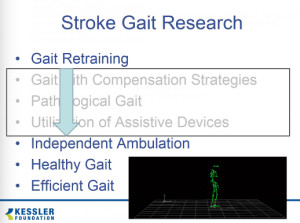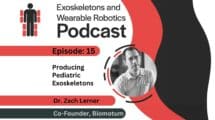Dr. Karen Nolan from the Kessler Foundation, presented on post-stroke gait recovery clinical trials with the Ekso GT exoskeleton by Ekso Bionics. Clinical trials are extremely important to demonstrate to doctors, rehabilitation professionals and insurers that medical exoskeletons are valuable. But what exactly is a clinical trial? What tests are the exoskeletons put through? What are professionals looking for? Dr. Karen Nolan PhD – Senior Research Scientist in Human Performance and Engineering Research at the Kessler Foundation – answered these questions at the 2nd Annual Technology and Development Day hosted by Ekso Bionics. She specializes in the rehabilitation of patients recovering from stroke. This is a new application for medical exoskeletons which until now were primarily focused on patients with spinal cord injury. Below is a synopsis of her talk:
Rehabilitation robotics is a recent addition to the medical field and is really starting to take off. Their use is rapidly expanding and evolving. Medical exoskeletons go beyond allowing someone to walk down the aisle in a wedding suit. Dr. Nolan thinks that exoskeletons can perform past what has reached the general media.
Dr. Nolan’s journey with medical exoskeletons began in April 2014. At the time, her boss allocated funds for the acquisition of an Ekso GT. Initially she was very skeptical, but with the help of the variable assist control software she was quickly sold on the concept.
The Ekso GT is a motorized wearable robot that can support the weight of the user and applies power to the hips and knees. The goal for the device in stroke patients is to retrain walking function after it has been lost. It is a reciprocal gait device (left-right alternative advancement of the two feet), initiated by weight shift which normally a healthy person would not think about. The Ekso GT encourages and facilitates weight shift when it has to be retrained. The goal of Ekso Bionics is to add this to the toolbox of professional physiotherapists, not replace them.

Rehabilitation exoskeletons fast forward to independent ambulation. Also, successful ambulation does not come at the cost of poor leg path that will require braces down the road. There is a limit to how much physical therapy can be done during the day because both the therapist and patient get fatigued. Exoskeletons provide high intensity, repetitive, task-specific rehabilitation much earlier while the brain is still healing. Finally, exoskeletons can also reduce the risk of injury for physiotherapists and allow them to work even after they get older. This would allow for more experienced physiotherapists that are not in peak physical condition to continue practicing.
The Kessler Foundation studies so far have included about 60 patients with no safety issues, falls, skin irritation, cardiac or pulmonary issues. The Ekso GT can be set up quickly without cutting into the time of 1 hour training sessions. Newer therapists are not as afraid of the new technology. Battery operated devices with a user interface intimidate some of the older therapists. Feasibility looks good: the suit can be adjusted quickly and used for stroke and brain injury in addition to spinal cord injury patients.
Numerical Analysis:
During initial evaluation patients walk 0 to 8 feet. During the first exposure to the Ekso GT, patients walk 442 feet or 431 steps. The exoskeleton makes every step be executed correctly. Research shows exoskeleton users were more engaged by having numerical data downloaded from the device at the end of each session. Patients were also consistently walking further with exoskeletons compared to those without. More data is being collected to reach a verdict if use of an exoskeleton reduces total rehabilitation time.
The Kessler Foundation is looking at more numerical data and bioengineering analysis to categorize the benefits of exoskeletons. Dr. Nolan showed images of a full virtual gait analysis model of patients using the suit. In another study, EMG sensors were placed along the legs to measure the leg muscle’s activation signal strength with the Ekso GT. While cognitive improvement was not significant, it was shown that the users were not just “riding” the exoskeleton. The wearable robot retrains patients to make more symmetrical steps which would not be performed if the patient has not properly shifted their weight first.
On a good day, the Ekso GT can do 1 mile/hour compared to a normal person that would walk at about 3 miles/hour. Furthermore, standing breaks in an exoskeleton are therapeutic, vs traditional sitting ones that have no rehabilitation value.
Variable Assist Is A Game Changer!

Surprisingly, Dr. Nolan’s main praise for the Ekso GT was not focused on the hardware, but its variable assist software. Initially introduced in 2013, it allows clinicians to target deficient aspects of patients’ gait (see Ekso Bionics site for more information on variable assist). Variable assist programming on the fly for each patient was key to the success of the Ekso GT. For example, some stroke patients are paralyzed on only one side of their body. The rehabilitation exoskeleton should therefore behave completely differently if the patient steps with the left or right foot. If it provides too much assistance then the patient is not exercising. Variable assist software allows for this necessary customization and it has become a game changer.
The biggest challenge to use the Ekso GT has been size. Some patients are too tall, too short or too wide. Another obstacle has been patients that are not interested in new technologies and would like to use only “true and proven” rehabilitation techniques. Physiotherapists would like to perform pediatric studies but the Ekso GT has to be shrunk considerably for this to happen. Pediatric exoskeletons are still limited to Hocoma (Lokomat), Marsi-Bionics (Atlas), and SuitX.
Initially the funds from Kessler were for 1 Ekso GT which allowed for all of the beginning research. All of the current research is independently conducted primarily using 5 Ekso GT suits. Each suit comes with 2 batteries, one in the suit while the other one is charging. The batteries last 3 to 4 hours and are easy to switch between sessions. The battery casings are safe and have passed all international safety standards.
The Takeaways:
- 5 minutes to set up the device, 600 quality steps, flexible to be used for people with different diagnosis and rehabilitation needs
- Complete spinal cord injury is only a small fraction of gait rehabilitation patients. The research by the Kessler Foundation opens the door for the Ekso GT to be used on patients with incomplete spinal cord injury or paralysis from a stroke.
- Potential for positive effects after long term exoskeleton use. There are traditional techniques that yield no results until the patient has taken 10,000 or more steps, most likely due to the nature of brain plasticity. Exoskeletons have not been around long enough to conduct such long term studies.
- Importance of adaptable software (variable assist), otherwise the device is just “ridden along.”
Don’t forget to visit the Kessler Foundation website.








3 Comments